The G text has forced me to accept as fact that
number 107 was important. One of the reasons could have been
that by combining 107 with 73 - the
day number for March 14 (3-14, π) -
the result of sticking these measures together becomes 180:
|
314 * 1½ =
471
= 16 * 29½ - 1 |
7 * 52 =
364
= 365 - 1 |
|
472 - 365 =
107
= 180
- 73 |
229 + 242 = 471 is the
number of glyphs on the G tablet and how can 107 be joined to
73? The answer ought to be found at Manus Catenata:
|
JANUARY
9 |
10
(*295) |
11 |
12 (377
= 365 + 12) |
13 (378
= Saturn) |
|
TERMINALIA |
24
(*340) |
25 |
26
(422) |
27
(58) |
 |
 |
 |
 |
 |
|
Ca13-16 |
Ca13-17
(360) |
Ca13-18 |
Ca13-19 |
Ca13-20
(392 - 29) |
| oho
te vae |
tagata puoko erua |
tagata puo pouo |
vero hia |
- |
|
March 15 |
16 (440) |
17 |
18 (77 = 377 - 300) |
19 (*366
+ 77) |
|
March 18 |
19 |
20
(*364) |
0h |
22 |
|
DZANEB |
*363 |
θ
OCTANTIS |
SIRRAH |
ALGENIB
PEGASI |
|
388 |
389 |
390 |
391 |
392 |
|
28 |
 |
348 |
|
*Ca14-29 (392) |
|
te rima |
|
377 = 13 * 29 |
Earlier I used much time and effort
in order to search for a border line between the
sequence of heliacal days beginning with Ga1-1 and
ending somewhere before the end of side b.
Reading the text in the opposite
direction (withershins so to say) I had concluded
this way of reading could hardly go beyond Sirrah at
0h. There it had to be stopped. Moving withershins
meant going forward in precessional time and it
could not be tolerated to move further into the future
than beyond the present - as defined by heliacal Sirrah,
the woman in the corner who never moved and who was
'stone' from waist down:
|
JANUARY 15 (*300) |
16 |
17 |
18 (383) |
 |
 |
 |
 |
|
Gb6-25 (229 +
178) |
Gb6-26 (408) |
Gb6-27 (180) |
Gb6-28 |
 |
 |
 |
 |
|
Gb3-10 (300) |
Gb3-11 |
Gb3-12 (73) |
Gb3-13 |
|
θ OCTANTIS
(364.4) |
Al
Fargh al Thāni-25
0h (365.25)
CAPH = β Cassiopeiae,
SIRRAH
= α Andromedae
(0.5), ε Phoenicis, γ³ Oct. (0.8) |
Uttara Bhādrapadā-27
/
Wall-14
ο Oct. (1.3),
ALGENIB
PEGASI
= γ Pegasi
(1.8) |
χ Pegasi (2.1),
θ Andromedae
(2.7) |
|
March 20 |
21 (0h) |
22 (*1) |
23 (82) |
|
°March 16 (*360) |
17 |
18 (77) |
19 |
|
'February 21 (52) |
22 (418) |
TERMINALIA |
24 (*340) |
|
"February 7 (403) |
8 (*324) |
9 (40) |
10 |
|
NAKSHATRA DATES: |
|
JULY 17 (*118) |
18 |
19 (200) |
20 |
|
12h (182.6)
ο VIRGINIS
(182.1), η Crucis (182.5) |
ALCHITA
= α Corvi, MA WEI (Tail of the Horse) = δ
Centauri
(183.1),
MINKAR = ε Corvi
(183.7),
ρ Centauri (183.9) |
PÁLIDA = δ Crucis
(184.6),
MEGREZ = δ Ursae Majoris
(184.9) |
Hasta-13 /
Chariot-28
GIENAH
= γ Corvi(185.1),
ε Muscae
(185.2), ζ Crucis (185.4),
ZANIAH = η Virginis
(185.9) |
|
September 19 (*182) |
20 |
21 (264) |
EQUINOX |
|
°September 15 (*178) |
16 |
17 (260) |
18 |
|
'August 23 (*155) |
24 (236) |
25 |
26 |
|
"August 9 (*141) |
10 (222) |
11 |
12 |
 |
 |
 |
 |
|
Ga5-8 (118) |
Ga5-9 |
Ga5-10 |
Ga5-11 |
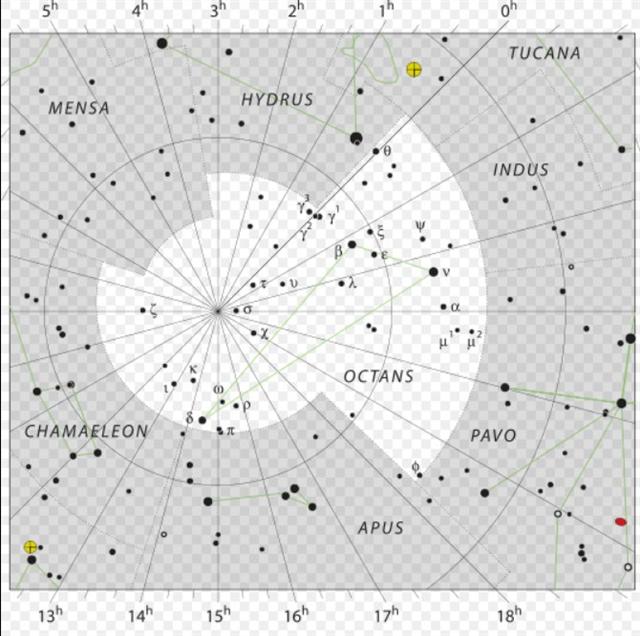
18h / 24h * 364 = 273, and 364 - 273
(September 30) = 91 = 13 weeks is approximately the
distance from Φ
to
θ.
|
Egyptian bread, (-t, female
determinant) |
 |
Phoenician qoph |
 |
Greek
phi |
Φ(φ) |
|
...
is the 21st letter of the Greek
alphabet ... Its origin is uncertain
but it may be that phi originated as
the letter qoppa ... In traditional
Greek numerals, phi has a value of
500 or 500000 ...
Isaac Taylor,
History of the Alphabet: Semitic
Alphabets, Part 1, 2003: 'The
old explanation, which has again
been revived by Halévy, is that it
denotes an 'ape,' the character Q
being taken to represent an ape with
its tail hanging down. It may also
be referred to a Talmudic root which
would signify an 'aperture' of some
kind, as the 'eye of a needle,' ...
Lenormant adopts the more usual
explanation that the word means a
'knot' ...
... The king, wearing now a short,
stiff archaic mantle, walks in a
grave and stately manner to the
sanctuary of the wolf-god Upwaut,
the 'Opener of the Way', where he
anoints the sacred standard and,
preceded by this, marches to the
palace chapel, into which he
disappears. A period of time elapses
during which the pharaoh is no
longer manifest.

When he reappears he is clothed as
in the Narmer palette, wearing the
kilt with Hathor belt and
bull's tail attatched. In his right
hand he holds the flail scepter and
in his left, instead of the usual
crook of the Good Shepherd, an
object resembling a small scroll,
called the Will, the House Document,
or Secret of the Two Partners, which
he exhibits in triumph, proclaiming
to all in attendance that it was
given him by his dead father
Osiris, in the presence of the
earth-god Geb. 'I have run',
he cries, 'holding the Secret of the
Two Partners, the Will that my
father has given me before Geb.
I have passed through the land and
touched the four sides of it. I
traverse it as I desire.' ... |
|
Egyptian
nfr |
 |
Phoenician
teth |
 |
Greek
theta |
Θ (θ) |
|
... The form of the letter
θ suggests a midline ('waist'),
although the origin of θ is the
Phoenician tēth which
means 'wheel'. This in turn
could have originated from a
glyph named 'good' which in
Egypt was nfr ...
... θ is the last star in the
Ara constellation, and the
ancient meaning of this letter
was described as a wheel by the
Phoenicians but for the Egyptian
it meant 'good'.
When the wheel of time has come
full cycle around and the upside
down fire-altar is in the past
the times ahead should be good
(or lucky Sa'ad)
...
According to Wilkinson
nefer
originally depicted the throat
and heart of a sheep:

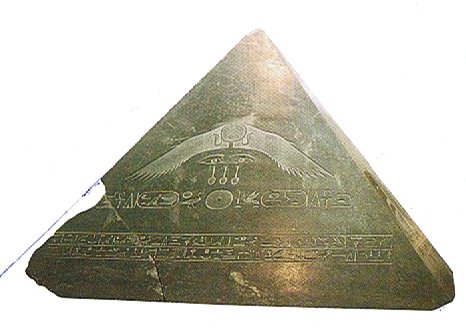 |
|
APRIL 17 (107) |
18 |
19 |
20 (*30) |
21 |
 |
 |
 |
 |
 |
|
Ga1-27 |
Ga1-28 |
Ga1-29 |
Ga1-30 |
Ga2-1 |
|
6h (91.3) |
ξ ORIONIS
(92.5) |
Al Han'ah-4 /
Maru-sha-pu-u-mash-mashu-7
(Front of the Mouth of the Twins)
TEJAT PRIOR
= η Gemini
(93.4), γ Monocerotis (93.5), κ Aurigae
(93.6), κ Columbae (93.8) |
FURUD
= ζ Canis Majoris
(94.9) |
Well-22 /
Arkū-sha-pu-u-mash-mashu-8 (Back of
the Mouth of the Twins)
δ Columbae (95.2),
TEJAT POSTERIOR
= μ Gemini, MIRZAM = β Canis Majoris
(95.4),
CANOPUS
= α Carinae
(95.6), ε Monocerotis (95.7), ψ1 Aurigae
(95.9) |
|
ν Orionis (91.4), θ Columbae (91.5), π
Columbae (91.6) |
|
June 20 |
SOLSTICE |
22 (*93) |
23 (174) |
ST JOHN'S DAY |
|
°June 16 |
17 (168) |
18 |
19 |
20 (*91) |
|
'May 24 (144) |
25 |
26 |
27 |
28 (*68) |
|
"May 10 (130) |
11 |
12 |
13 |
14 (*54) |
|
NAKSHATRA DATES: |
|
OCTOBER 17 (290) |
18 |
19 |
20 |
21 (*214) |
|
ZHŌNGSHĀN = ο Herculis
(274.0), π Pavonis (274.6) |
ι Pavonis
(275.1),
POLIS
= μ Sagittarii
(275.9)
MENKAR (α
Ceti)
|
η Sagittarii
(276.9) |
Purva Ashadha-20 |
|
KAUS MEDIUS = δ Sagittarii,
κ Lyrae (277.5),
TUNG HAE (Heavenly Eastern Sea) = η
Serpentis
(277.7),
SHAOU PIH (Minor Minister) = φ Draconis
(277.8),
KWEI SHE = χ Draconis
(277.9) |
φ OCTANTIS
(278.1),
KAUS AUSTRALIS = ε Sagittarii
(278.3), ξ
Pavonis (278.4),
AL ATHFAR = μ Lyrae
(278.6) |
|
December 20 |
SOLSTICE |
22 |
23 (357) |
CHRISTMAS EVE |
|
°December 16 |
17 |
18 |
19 (*273) |
20 (354) |
|
'November 23 (327) |
24 |
25 |
26 (*250) |
27 |
|
"November 9 |
10 (314) |
11 |
12 (*236) |
13 |
My earlier conclusions can therefore be
confirmed as probably correct. And the distance from
Sirrah in Gb6-26 down to the time of Aldebaran in
Ga1-4 was 68 days:
|
61 |
0h |
MARCH 22 (*1) |
23 (82) |
|
no glyph |
 |
 |
|
Ga1-1 |
Ga1-2 |
|
HYADUM II = δ¹ Tauri
(64.2) |
Net-19
AIN (Eye)
= ε Tauri, θ¹ Tauri, θ² Tauri
(65.7) |
no star listed (66) |
|
May 24 |
25 (145) |
26 (*66) |
|
°May 20 |
21 (*61) |
22 (142) |
|
'April 27 |
28 (118) |
29 (*39) |
|
"April 13 |
14 (104) |
15 (*25) |
|
NAKSHATRA DATES: |
|
SEPTEMBER 20 (*183) |
21 (264) |
EQUINOX |
|
Heart-5
σ SCORPII
(247.0),
HEJIAN = γ Herculis
(247.2), ψ
Ophiuchi (247.7) |
ρ Ophiuchi
(248.1),
KAJAM = ω Herculis
(248.3), χ
Ophiuchi (248.5),
SHE LOW (Market Tower) = υ Ophiuchi,
Tr. Austr. (248.7), ζ Tr. Austr. (248.8) |
Al Kalb-16
/
Jyeshtha-18 /
ANA-MUA-1 (Entrance pillar)
ANTARES
= α Scorpii
(249.1),
MARFIK = λ Ophiuchi,
φ Ophiuchi (249.5), ω Ophiuchi (249.8) |
|
November 23 (327) |
24 |
25 (*249) |
|
°November 19 |
20 (*244) |
21 (325) |
|
'October 27 (300) |
28 |
29 (*222) |
|
"October 13 (286) |
14 |
15 (*208) |
At the time of Bharani (*41)
the distance down to Aldebaran had been only *68 -
*41 = 14 precessional days and at that time the
heliacal date was May 28 (148) - 41 = 107 ("April
17) with the Full Moon positioned *210 - *27 = 183
nights later.
But Andromeda
seems always to have played her role as the junction between
a pair of
years:
...
There is a couple residing in one place named Kui
and Fakataka [creating a circle].
After the couple stay together for a while
Fakataka is pregnant. So they go away because
they wish to go to another place - they go. The
canoe goes and goes, the wind roars, the sea churns,
the canoe sinks. Kui expires while
Fakataka swims. Fakataka swims and swims,
reaching another land. She goes there and stays on
the upraised reef in the freshwater pools on the
reef, and there delivers her child, a boy child. She
gives him the name Taetagaloa. When the baby
is born a golden plover flies over and alights upon
the reef. (Kua
fanau lā te pepe kae lele mai te tuli oi tū mai i te
papa).
And so
the woman thus names various parts of the child
beginning with the name 'the plover' (tuli):
neck (tuliulu), elbow (tulilima), knee
(tulivae) ...

Perseus picked one star ('eye',
mata) from above and one from
below. Then he walked to the Sea Beast
(Cetus, Ketos) to show him time was ripe for
moving with legs (oho te vae), time to leave
the Sea.
...
During his descent the ancestor still possessed the
quality of a water spirit, and his body, though
preserving its human appearance, owing to its being
that of a regenerated man, was equipped with four
flexible limbs like serpents after the pattern of
the arms of the Great Nummo.
The ground was rapidly approaching. The ancestor was
still standing, his arms in front of him and the
hammer and anvil hanging across his limbs. The shock
of his final impact on the earth when he came to the
end of the rainbow, scattered in a cloud of dust the
animals, vegetables and men disposed on the steps.
When calm was restored, the smith was still on the
roof, standing erect facing towards the north, his
tools still in the same position. But in the shock
of landing the hammer and the anvil had broken his
arms and legs at the level of elbows and knees,
which he did not have before. He thus acquired the
joints proper to the new human form, which was to
spread over the earth and to devote itself to toil
...
A visual representation of the
Chained Hand (ι, λ, and κ Andromedae)
was probably given
in Ga5-1:
|
JULY 10 |
11 |
12 (193) |
13 |
14 (*115) |
|
AUGUST 20 |
21 |
22 (234) |
23 |
24 (*156) |
 |
 |
 |
 |
 |
|
Ga5-1 |
Ga5-2 |
Ga5-3 |
Ga5-4 |
Ga5-5 (115) |
|
θ Crateris (175.0), υ Leonis (175.2), ω
Virginis (175.3), ι Crateris (175.5) |
ο Hydrae (176.1) |
ζ Crateris,
ξ VIRGINIS
(177.0), λ Muscae (177.1), ν Virginis
(177.2), μ Muscae (177.8) |
Al Sarfah-10 /
Uttara Phalguni-12 /
Zibbat A.-16
(Tail of the Lion) / Shēpu-arkū sha-A-17
(Hind Leg of the Lion)
93 LEONIS
(178.0),
DENEBOLA
= β Leonis
(178.3),
ALARAPH
= β Virginis
(178.6) |
PHEKDA = γ Ursae Majoris,
β Hydrae (179.3), η Crateris (179.9)
DENEB CYGNI (α Cygni)
|
|
September 12 |
13 |
14 (*177) |
15 |
16 (259) |
|
°September 8 |
9 (*172) |
10 |
11 (254) |
12 |
|
'August 16 |
17 (229) |
18 (*150) |
19 |
20 |
|
"August 2 (214) |
3 |
4 (*136) |
5 |
6 |
|
NAKSHATRA DATES: |
|
JANUARY 9 |
10 (*295) |
11 |
12 |
13 (378) |
|
FEBRUARY 19 |
20 (*336) |
21 |
22 (53) |
TERMINALIA |
|
λ Piscium
(358.0),
MANUS CATENATA
= ι, λ, and κ Andromedae
(358.1),
ALRAI = γ Cephei, θ Phoenicis
(358.4), κ Andromedae (358.7) |
ω Aquarii
(359.2),
78 Pegasi
(359.5) |
ψ Andromedae
(360.1),
σ Phoenicis
(360.4) |
γ¹ Oct. (361.4),
φ Pegasi (361.7) |
DZANEB = ω Piscium
(362.4), γ² Oct. (362.8) |
|
3-14 |
March 15 |
16 (*360) |
17 |
18 (77) |
|
°March 10 |
11 (*355) |
12 |
13 |
3-14 |
|
'February 15 |
16 (*332) |
17 |
18 |
19 (50) |
|
"February 1 |
2 (*345) |
3 |
4 |
5 (36) |
|
5 |
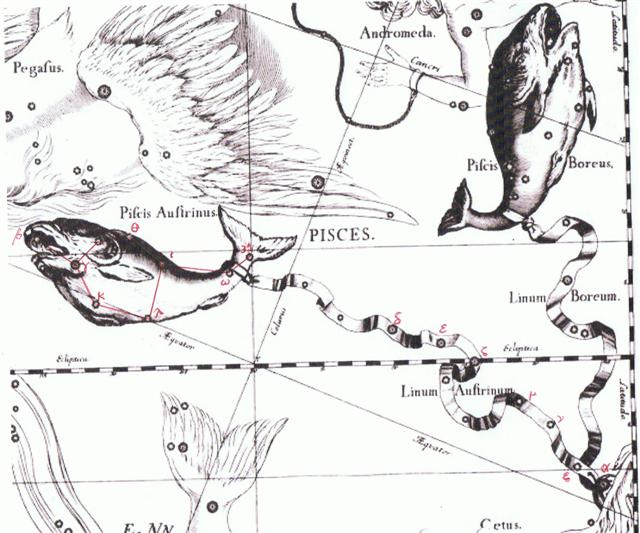
The tail of the Southern Fish in
Pisces (ω) has been
named Dzaneb which I guess means Deneb
(tail). This female (horizontal) fish cannot move away
withershins (>), because of the band connecting her
to the rising Northern Fish - which in
turn was defined from the left elbow and upper torso
of Andromeda.

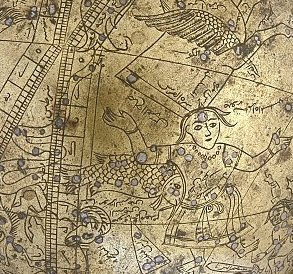
In the Babylonian
ecliptic list the Tail of the Lion
(Denebola,
β)
was
the only junction station (with also
the following station positioned in
the same day):
|
BABYLONIAN ECLIPTIC
CONSTELLATIONS: |
|
26 |
Mahar sha hi-na Shahū |
Western One in the Tail
of the Goat |
γ (Nashira)
Capricorni |
328.0 |
Febr 12 (43) |
|
27 |
Arkat sha hi-na Shahū |
Eastern One in the Tail
of the Goat |
δ (Deneb Algiedi)
Capricorni |
329.8 |
Febr 13 (44) |
|
|
|
0 |
1-iku |
Field measure |
τ
(Anunitum)
Piscium |
16.5 |
April 6 (96) |
|
|
|
1 |
Mahrū-sha-rishu-ku |
Front of the Head of Ku |
β (Sheratan),
γ (Mesarthim) Arietis |
27.4 |
April 17 (107) |
|
2 |
Arku-sha-rishu-ku |
Back of the Head of Ku |
α (Hamal)
Arietis |
30.5 |
April 20 (110) |
|
|
|
3 |
Temennu |
Foundation Stone |
η (Alcyone)
Tauri |
56.1 |
May 16 (136) |
|
4 |
Pidnu-sha-Shame |
Furrow of Heaven |
α (Aldebaran)
Tauri |
68.2 |
May 28 (148) |
|
5 |
Shur-narkabti-sha-iltanu |
Star in the Bull towards
the north |
β (El Nath)
Tauri |
80.9 |
June 9 (160) |
|
6 |
Shur-narkabti-sha-shūtū |
Star in the Bull towards
the south |
ζ (Heavenly Gate)
Tauri |
84.0 |
June 13 (164) |
|
|
|
7 |
Maru-sha-pu-u-mash-mashu |
Front of the Mouth of
the Twins |
η (Tejat Prior)
Gemini |
93.4 |
June 22 (173) |
|
8 |
Arkū-sha-pu-u-mash-mashu |
Back of the Mouth of the
Twins |
μ (Tejat Posterior)
Gemini |
95.4 |
June 24 (175) |
|
9 |
Mash-mashu-sha-Risū |
Twins of the Shepherd
(?) |
γ (Alhena)
Gemini |
103.8 |
July 2 (183) |
|
10 |
Mash-mashu-Mahrū |
Western One of the Twins |
α (Castor)
Gemini |
113.4 |
July 12 (193) |
|
|
|
11 |
Mash-mashu-arkū |
Eastern One of the Twins |
β (Pollux)
Gemini |
116.2 |
July 15 (196) |
|
12 |
Arkū-sha-nangaru-sha-shūtu |
Southeast Star in the
Crab |
δ
(Ascellus Australis)
Cancri |
131.4 |
July 30 (211) |
|
13 |
Rishu A. |
Head of the Lion |
ε (Ras Elaset Australis)
Leonis |
146.6 |
Aug 14 (226) |
|
14 |
Sharru |
King |
α (Regulus)
Leonis |
152.7 |
Aug 20 (232) |
|
15 |
Maru-sha-arkat-Sharru |
4th Son behind the King |
ρ (Shir)
Leonis |
158.9 |
Aug 26 (238) |
|
16 |
Zibbat A. |
Tail of the Lion |
β (Denebola)
Leonis
|
178.3 |
Sept 15 (258) |
|
17 |
Shēpu-arkū sha-A |
Hind Leg of the Lion |
β (Alaraph)
Virginis |
178.6 |
Sept 15 (258) |
|
18 |
Shur-mahrū-shirū |
Front or West Shur (?) |
γ (Porrima)
Virginis |
191.5 |
Sept 28 (271) |
|
|
|
19 |
Sa-Sha-Shirū |
Virgin's Girdle |
α (Spica)
Virginis |
202.7 |
Oct 9 (282) |


This was at the
opposite side of the year
compared to the Chained Woman.
This was where instead there
arrived a
woman full of life.
This was a
position where fresh water
became plentiful, where the dry
Lion season changed into a
season of rain and plenty, where
the Sky (the Lion, the Puma) and
Mother Earth (Virgo) again were
joined together in happy close embrace.
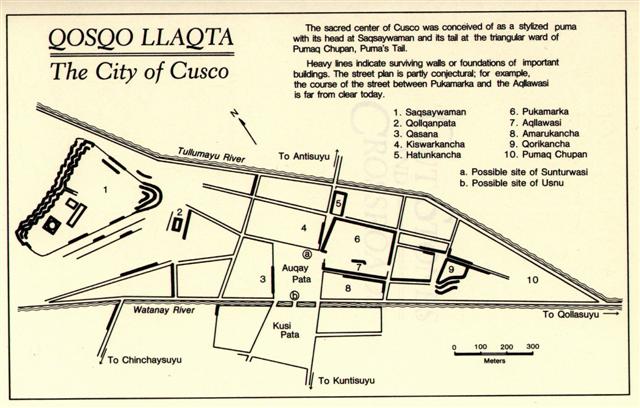
|
































